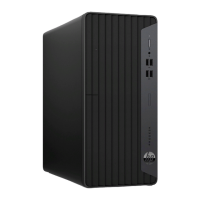Table 5-4 Computer Setup—Power
Option Description
OS Power Management
●
Runtime Power Management— Enable/Disable. Allows certain operating systems to reduce
processor voltage and frequency when the current software load does not require the full
capabilities of the processor. Default is enabled.
●
Idle Power Savings—Extended/Normal. Allows certain operating systems to decrease the
processors power consumption when the processor is idle. Default is extended.
●
Unique Sleep State Blink Rates—Enable/Disable. This feature is designed to provide a visual
indication of what sleep state the system is in. Each sleep state has a unique blink pattern. Default
is disabled.
NOTE: For Windows systems with Fast Boot support, a normal shutdown goes to the S4 state.
◦
S0 (On) = Solid white LED.
◦
S3 (Stand By)= 3 blinks at 1Hz (50% duty cycle) followed by a pause of 2 seconds (white LED)
— repeated cycles of 3 blinks and a pause.
◦
S4 (Hibernation)= 4 blinks at 1Hz (50% duty cycle) followed by a pause of 2 seconds (white
LED) — repeated cycles of 4 blinks and a pause.
◦
S5 (Soft Off) = LED is off.
Hardware Power
Management
SATA Power Management – Enables or disables SATA bus and/or device power management. Default is
enabled.
S5 Maximum Power Savings – Turns off power to all nonessential hardware when system is off to meet
EUP Lot 6 requirement of less than 0.5 Watt power usage. Default is disabled.
S5 Wake on LAN—Enables or disables remotely waking up the computer from S5 (power is off) power
state. Default is disabled.
Thermal Fan idle mode—This bar graph controls the minimum permitted fan speed.
NOTE: This setting only changes the minimum fan speed. The fans are still automatically controlled.
Computer Setup—Advanced
NOTE: Support for specific Computer Setup options may vary depending on the hardware configuration.
Table 5-5 Computer Setup—Advanced (for advanced users)
Option Heading
Power-On Options Allows you to set:
●
POST messages (enable/disable). Enabling this feature will cause the system to display POST error
messages, which are error messages displayed on the monitor during the Power On Self Test if the
BIOS encounters some kind of problem while starting the PC. A POST error message will only display
on screen if the computer is capable of booting this far. If the POST detects an error before this
point, a beep code is generated instead. Default is disabled.
●
After Power Loss (off/on/previous state). Default is Power off. Setting this option to:
◦
Power off—causes the computer to remain powered off when power is restored.
◦
Power on—causes the computer to power on automatically as soon as power is restored.
◦
Previous state—causes the computer to power on automatically as soon as power is restored,
if it was on when power was lost.
NOTE: If you turn off power to the computer using the switch on a power strip, you will not be able to
use the suspend/sleep feature or the Remote Management features.
Computer Setup (F10) Utilities 61

